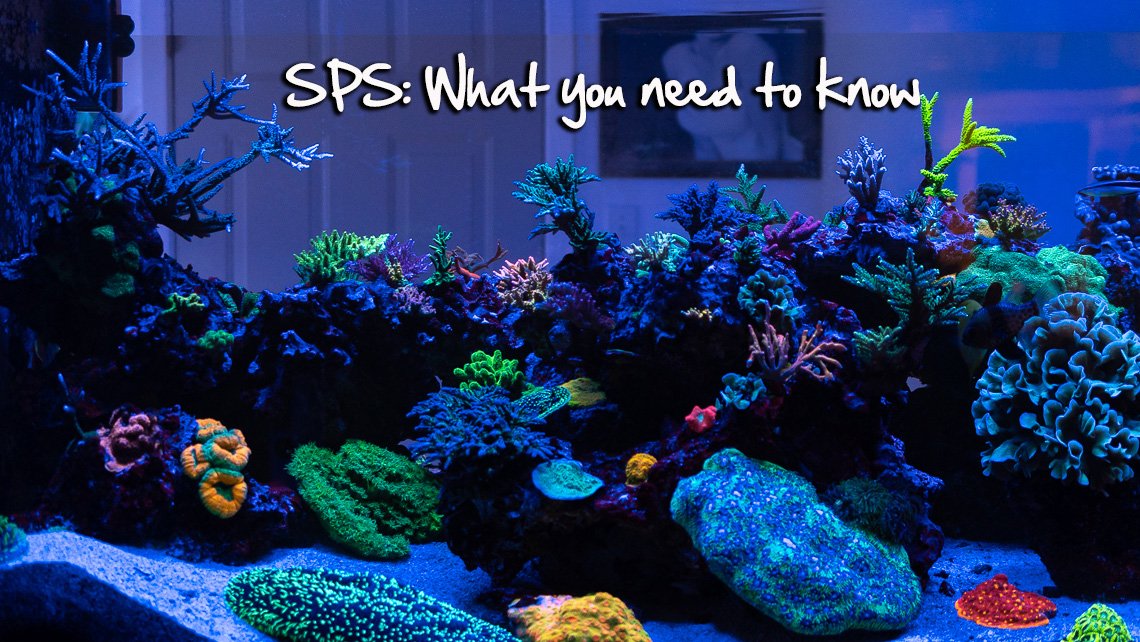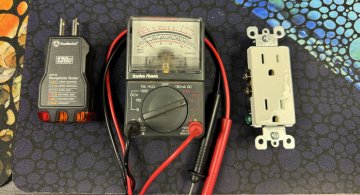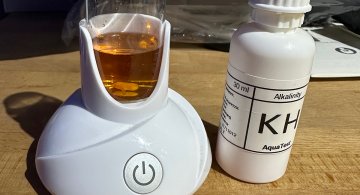What do SPS need? This is what you need to read
Acropora care
Acropora sp. - |LF|a-cro-POH-rah; alternate: a-CROP-o-rah|RF| - a species of calcium-based coral that causes frustration and loss of expendable income but brings joy and exuberance to the more detail-oriented caregivers.
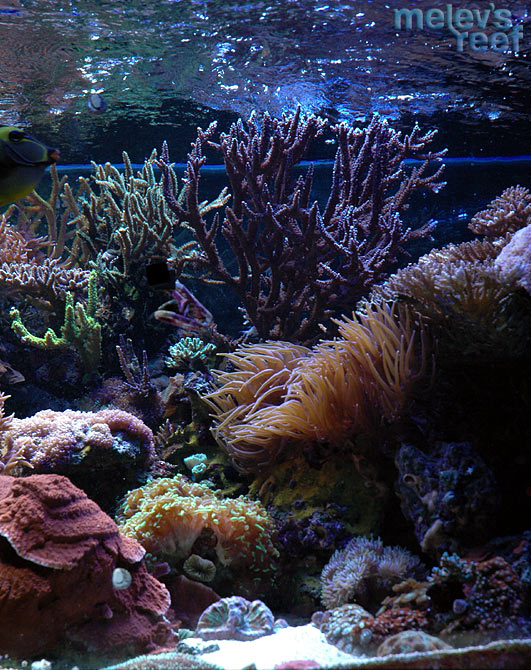
At our club meeting recently, I pointed out how keeping Acropora sp. is often considered the pinnacle of reef keeping. Hobbyists yearn for a full-blown tank that holds these colored sticks that grow into such interesting and unique shapes. The question isn't 'if' you can keep them, but rather 'how long' can you keep them alive to the point of enjoying some thriving colonies. Since they come in blue, green, red, orange, purple, yellow, brown and more, a living Acropora-laden reef can be quite the medal of honor if properly cared for.
I purchased my first SPS (small polyped stony) coral in 2002, and it was a Pocillopora. This little colony, no larger than a golf ball, was my starter piece to see if I had the skill to keep hard corals. Even with much to learn, that coral was a hardy one that tolerated the swings in water quality that my 29-gallon reef suffered from. After a few months, I decided to try Acropora as well, and have been keeping them ever since.
A larger tank tends to have more stable parameters, which is where the saying "dilution is the solution to pollution" likely came from. I can firmly state that a larger water volume does help keep pollution levels down, but when those numbers go south it can get costly trying to get them back where they belong. As hobbyists, the biggest impact you'll have on your reef tank has to do with your husbandry skills. The more often you test the water, the better your overview. You'll be quick to make minor adjustments to keep things on track. Another definition for the acronym SPS is "stability promotes success," as SPS definitely thrive under stable conditions.
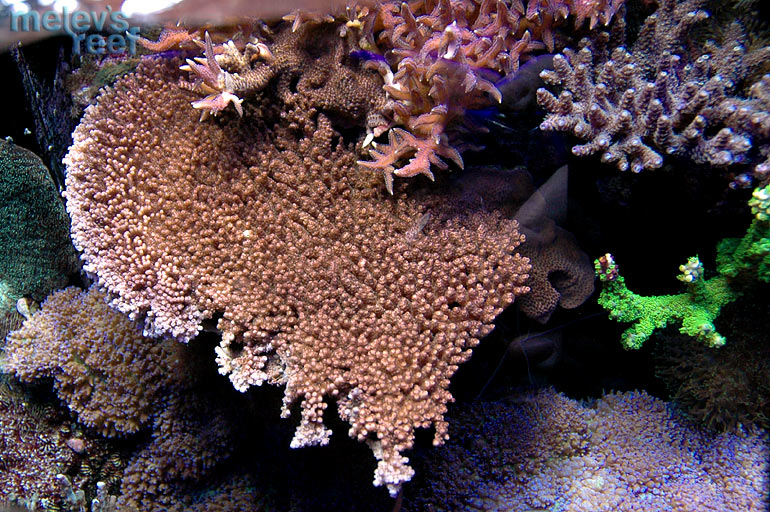
Acropora sp. come in various forms, from thick branchy types to very frail skeletons. They prefer rock solid parameters. Water temperatures don't vary much in their natural habitat, tending to move no more than one degree per day. Our tanks may go up and down two to three degrees in a 24 hour period, but with careful planning and good equipment it is possible to keep this variance tighter. Some species do better in cooler waters, but most tropical-based species seem to hold up well in tanks that range from 79F to 81F. This is simple a target range; if you prefer to keep your tank from 78F to 80F or 80F to 82F, likely you will have good results. The tanks that drop down to 76F or lower at night only to creep up to 82F or 83F daily - those corals are doing all they can to handle that seven degree swing on a regular basis. I don't recommend it. Please note, cooling fans coupled with timers can easily stabilize those summer months, and heaters connected to controllers will keep the water temperature 'normal' during the colder months.
Lighting continues to be an important part of Acropora keeping. Metal Halides (MH) are still the standard, but T5 lighting has probably taken up 20% of the market share if I had to guess. T5s are preferred because they emit less heat than MH and don't require a taller canopy. Be that as it may, I still believe some tanks would do better if the T5 bulbs were 7" off the water; closer to the water the corals seem to be affected by what continues to be untested UV radiation which likely leads to the pastel colors we see. Metal Halide bulbs are usually kept 9" to 12" off the water, if not higher in high quality reflectors. Anyone can tell the difference between MH and T5 lighting because of how the display appears to the human eye. MH lighting is a focal point that casts a shimmer effect and the reef tank has bright spots and shadows. T5 lighting appears continuous across the entire reef with no variances. Besides these choices, people are beginning to adopt LED lighting for their tanks, and my best advice is to borrow or buy a PAR meter to get some real measurements and avoid burning the corals with intense blasting light. Lift the fixtures higher or run them for shorter periods, gradually increasing the lighting period over multiple weeks until the corals are acclimated to the change. Keep the lights clean ( reflectors, glass shields and the bulb itself ) as spatter and salt film decrease light output that rob your tank of its intended light. Bulb color is a personal choice, but the general rule is 10,000K bulbs promote growth while 20,000K bulbs provide pretty coloration. A combination of bulbs can get the best of both, if you balance them out correctly. Normal lighting for a reef tank should be 9 to 10 hours per day, incorporating a staggered lighting period to include a 'high noon' duration (all lights are on at once blasting the tank) for a few brief hours will provide the best results.
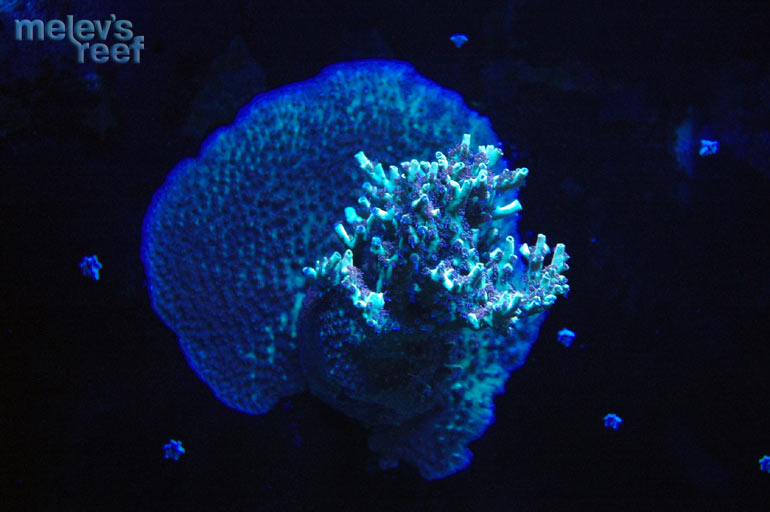
Coral placement is important. How far you distance your SPS corals from the lighting is something you'll learn with time, but often the best choice you can make is place the corals midway down in the aquarium. If they do well for a week or two, move them up a few inches higher and see if they can tolerate the greater PAR your lighting affords them. Find those sweet spots, and watch the corals closely to see if perhaps they'd be better a little further down in the rockwork. A PAR meter helps reduce some of this guesswork, but if we had rock-solid rules, this wouldn't be a hobby. We like to experiment a little. Once you know the spot is good for a coral, be sure to secure it to the rockwork with 2-part putty or Super Glue Gel. SPS corals tend to grow in more quickly when they are affixed firmly, rather than rocking back and forth in the flow. Corals need space to grow out, and if their neighbor is too close, one will usually lose to the other due to chemical warfare as they sting one another.
Flow is critical with Acropora. They need lots of flow to keep their core clean of any detritus which often leads to dying tissue. Once this tissue or skin is gone, nuisance algae is happy to grow in that dead area, spreading out gradually to consume more territory that erodes away more healthy tissue. Acropora colonies often ship in with 'bandit' crabs, commensal crabs that live within the branches and keep the coral clean. They eat tiny predators and ward off attacks by other livestock, but retreat deeply into the coral to avoid becoming a snack. If you get a coral and find such a crab, it would be best to set that little guy aside prior to quarantining and dipping the coral. Once the coral is safe to add to your display, reintroduce the bandit back into the colony and place it in your reef. Getting back to the topic of flow, this is primarily provided with pumps (Vortech, Tunze, Korallia, or Maxijets - these are the four most common choices in the U.S.) that move the water in the display area. Both Vortech and Tunze pumps allow the hobbyist to program in their preferred flow pattern, with chaotic random surges being the ultimate goal. Laminar flow isn't good for Acropora because the coral will simply grow leaning in one direction. Chaotic flow hits the coral from all sides and coupled with good lighting, each particular species of Acropora will grow into its own natural shape: tabling, pear shaped, bushy, branchy, and encrusting to any solid surface it can find.
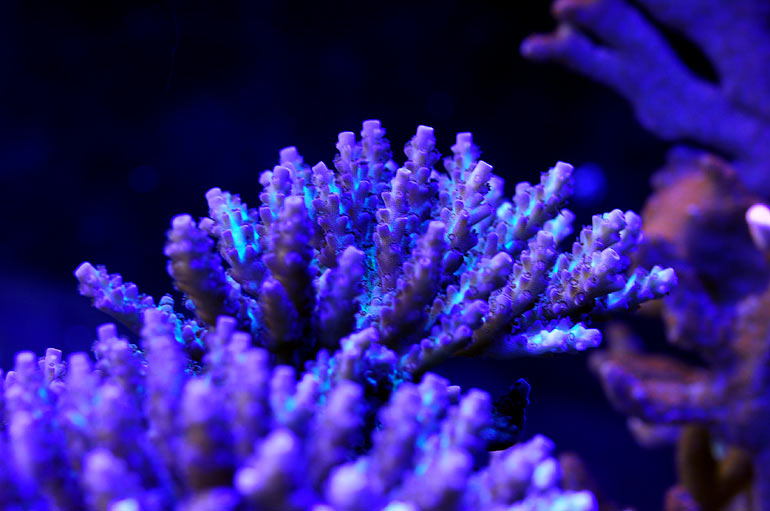
Water testing is important for Acropora keepers, who test alkalinity, nitrate, calcium, phosphate, magnesium, as well as salinity, temperature and pH. Keeping these numbers as consistent as possible is the goal. If one swings out of range, such as pH, the coral may stress and release stringy mucous into the water in response. If alkalinity drops too low, tissue will peel off the Acropora, usually around the base. Alkalinity, Calcium and Magnesium are very closely related and must be tested and supplemented continually to replace what the Acropora sp. are taking up from the water. Salinity should always be 1.026sg or 35ppt, and testers should use a calibrated refractometer that was set with 35ppt solution (not RO/DI water!) for accuracy.
Test Type Recommended Parameters matching Natural Sea Water (NSW)
- pH 7.9 to 8.3 - this varies from tank to tank; measuring with a Pinpoint Meter or controller is best
- Temperature 78° F to 84° F - average reef temperature tends to be ~81°F
- Alkalinity 8 to 11 dKH or 2.86 to 3.89 meq/L
- Calcium 390 to 450 ppm
- Magnesium 1350 - 1400 ppm (or 3x Calcium levels)
- Phosphate .03 ppm (leading cause of nuisance algae in your tank)
- Ammonia 0 - anything higher is toxic
- Nitrite 0 - anything higher is toxic
- Nitrate 10 ppm or less (huge water changes bring down nitrates)
Alkalinity and Calcium can be dosed with 2-part buffer solutions or provided with a calcium reactor, and this is a daily requirement for SPS. Magnesium has to be dosed as well, but this one is done every few weeks or longer, based on when the test kits reveals that it has become depleted. Magnesium tends to stay in the water for a long time. Keeping these three in line will keep pH levels up where they belong. Be sure to have current (not old) test kits on hand and use them frequently. Weekly isn't unheard of - its actually a good routine and avoids LRS (Lazy Reefer Syndrome). Be sure to keep a log of those numbers to track trends and learn how to dial in those parameters to maintain optimum conditions.
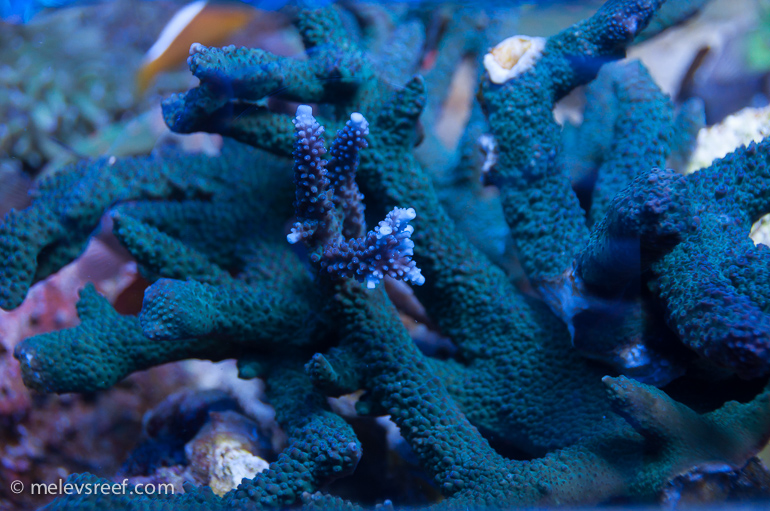
Phosphate and nitrate levels need to be as low as possible for Acropora sp. Elevated levels stunt their growth and fuel algae growth. Big water changes keep nitrate down, and phosphate removers are abundant to keep that parameter under control. Of course good filtration helps, which is handled with a quality protein skimmer, a refugium for nutrient export, and manually removing any settled waste in the overflows or sump. Rinse out filter socks and sponges often, every three days at least.
Acropora sp. have visible polyps, especially if you have a good macro lens. Each polyp has a mouth that can bring food down its digestive system, and the best free food you can feed this species is fish waste. Feed your fish and when they expel their waste into the water, the corals consume it. Corals that are very pale are usually so because they are starved, either due to a lack of fish or because of amino acid dosing (or due to excess intense lighting for too long a photoperiod). Feed a little more heavily and these corals will color up again.
It doesn't really take special equipment or vast amounts of money to keep these corals, but it doesn't hurt if you have either. Just remember that these are living corals that need your attention and without your TLC, they will decline. This is definitely a challenging species, but anyone that has kept them successfully will tell you it is worth the effort.
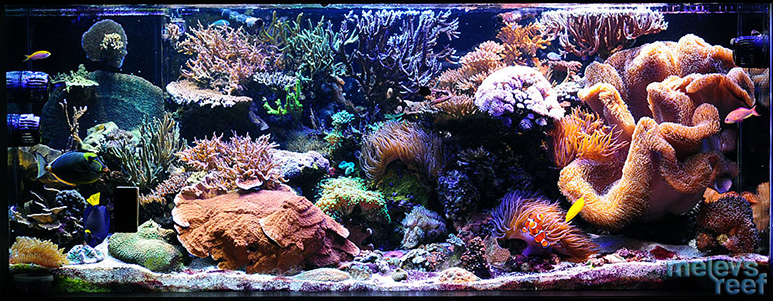
Happy reefing!
